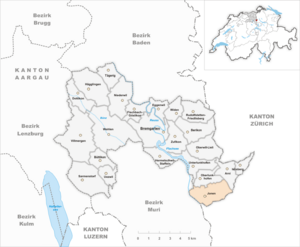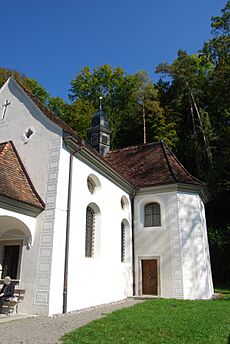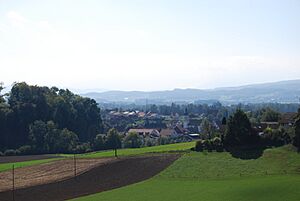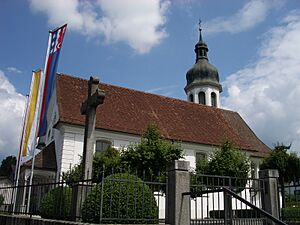Jonen facts for kids
Quick facts for kids
Jonen
|
||
|---|---|---|
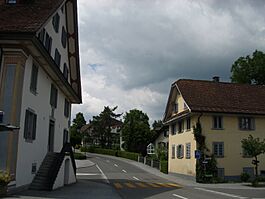 |
||
|
||
| Country | Switzerland | |
| Canton | Aargau | |
| District | Bremgarten | |
| Area | ||
| • Total | 5.7 km2 (2.2 sq mi) | |
| Elevation | 401 m (1,316 ft) | |
| Population
(Dec 2020 )
|
||
| • Total | 2,210 | |
| • Density | 388/km2 (1,004/sq mi) | |
| Postal code |
8916
|
|
| Surrounded by | Affoltern am Albis (ZH), Arni, Hedingen (ZH), Oberlunkhofen, Ottenbach (ZH), Rottenschwil | |
Jonen is a small town, also called a municipality, located in the canton of Aargau in Switzerland. It is part of the Bremgarten district.
Contents
History of Jonen
People have lived in the area around Jonen for a very long time! The oldest signs of settlements come from a large burial ground from the Hallstatt period. This was an ancient time in Europe, long before the Romans.
Later, there were also remains of a Roman farm found in a place called Schalchmatthau. An old cemetery from the 6th or 7th century, belonging to the Alemanni people, was also discovered.
The town of Jonen was first officially mentioned in the year 1243. It was called Jonun back then. In 1291, a powerful ruler named Rudolf von Habsburg took control of the area.
Over time, Jonen became part of a larger area known as the Kelleramt. In 1415, this area came under the control of Zurich, a major Swiss city. For many years, the local church taxes (called tithes) were paid to different religious places. Jonen was part of the Lunkhofen parish (a church district) until 1866, when it became its own independent parish.
A Protestant chapel was first mentioned in 1598. This chapel was rebuilt in 1804. Sadly, in 1811, a big fire destroyed two-thirds of the village, including the chapel. It was rebuilt again and made bigger in 1910. Since 1866, it has served as the main parish church for Jonen.
The first schoolhouse in Jonen was built in 1808. Since 1972, Jonen has been home to a district school for older students.
Since 1920, a bus has connected Jonen to nearby towns like Bremgarten and Affoltern am Albis. For a long time, farming and dairy production were the main jobs in Jonen. However, by 2000, there were only 15 farms left. Today, many people who live in Jonen travel to work in bigger cities like Bremgarten and Zurich.
Geography of Jonen
Jonen covers an area of about 5.7 square kilometers (about 2.2 square miles). A large part of this land, about 57.7%, is used for farming. Forests cover about 30.5% of the area. The rest of the land is used for buildings and roads (10%) or is non-productive, like rivers (1.8%).
The main part of the village is on flat land near the Reuss River. The highest point in Jonen is a mountain in the east, which is about 559 meters (1,834 feet) high. Jonen is surrounded by several other towns, including Oberlunkhofen, Arni, Affoltern am Albis, Ottenbach, Aristau, and Rottenschwil.
The municipality of Jonen includes the main village and two smaller settlements called Obschlagen and Litzi.
Jonen's Coat of Arms
The blazon (a special description) of Jonen's coat of arms is: Tierced per pale wavy Azure three Mullets Argent in pale, Argent and Gules a Key Argent. This means the shield is divided into three wavy vertical sections. The first section is blue with three silver stars. The middle section is silver, and the last section is red with a silver key.
Population and People
Jonen has a population of about 2,210 people. About 11% of the people living in Jonen are from other countries. Most people in Jonen speak German (about 94.9%). Other languages spoken include Serbo-Croatian and Italian.
The people in Jonen are generally well-educated. Many adults (between 25 and 64 years old) have completed higher education. In the 2008/2009 school year, there were 188 students in primary school and 223 students in secondary school in Jonen.
The population of Jonen has grown quite a bit over the years:
| Historical population | ||
|---|---|---|
| Year | Pop. | ±% |
| 1850 | 788 | — |
| 1900 | 630 | −20.1% |
| 1950 | 570 | −9.5% |
| 1980 | 800 | +40.4% |
| 2000 | 1,569 | +96.1% |
Important Heritage Sites
The pilgrimage chapel in Jonental is a very important historical site. It is listed as a Swiss heritage site of national significance, meaning it's a special place that is protected and valued for its history and culture.
The village of Jonen itself, along with the small settlements of Obschlagen and Litzi, are also recognized as important parts of Switzerland's heritage.
Economy and Jobs
In 2007, the unemployment rate in Jonen was low, at 1.47%. This means most people who wanted to work had jobs.
Jobs in Jonen are divided into three main types:
- Primary sector: This includes jobs like farming. In 2005, about 72 people worked in this sector.
- Secondary sector: This includes jobs in manufacturing or construction. About 190 people worked in this sector.
- Tertiary sector: This includes jobs in services, like shops, offices, or healthcare. About 200 people worked in this sector.
Many people who live in Jonen travel to other towns for work. In 2000, about 78.4% of the people living in Jonen worked outside the municipality. About 17.4% of workers used public transportation to get to their jobs, while 56.2% used a private car.
Religion in Jonen
According to the 2000 census, most people in Jonen are Roman Catholic (about 56.4%). A significant number of people (about 28.4%) belong to the Swiss Reformed Church.
See also
 In Spanish: Jonen para niños
In Spanish: Jonen para niños





